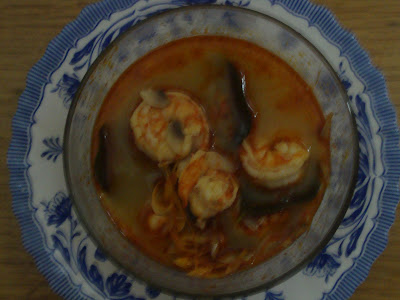Rendang Padang(Beef)
Minangkabau or padang is the beautiful place in west Sumatera
province in Indonesia.they have so many culture and kuliner.one of the famous
food from there is RENDANG,this kind of
food is one of the pioneer in restaurant
padang because very delicious .rendang
made from beef combine with spices . If you’re sick and tired of the same old
way of cooking beef—consider beef rending. Tender moist flavorful morsels of
beef coated with exotic spices--this dry stew is bound to tease your taste buds
to no ends. Although it originated in west-central Sumatra, Indonesia, this
dish is also popular in Malaysia and Singapore. Different regions of South-east
Asia have developed their own special way of preparing this dish, but the main
ingredients remain pretty much the same.
Ingredients
- 1 teaspoon salt
- 1 teaspoon ground coriander seed
- 1/4 teaspoon ground turmeric
- 1 inch ginger roughly
chopped
- 4 large cloves garlic roughly
chopped
- 4 large shallots roughly
chopped (about 7 ounces)
- chili pepper flakes to taste (I used about 3 tablespoons)
- 2 tablespoons vegetable oil
- 2 pounds beef shanks or shortribs cut into large cubes
- 2 stalks lemongrass white
part only, smashed
- 4 kaffir lime leaves
- 1 inch galangal sliced
into coins
- 2 packs freeze dried coconut cream rehydrated in 2 cups of warm water, or 1 can
coconut milk
- 1 tablespoon palm sugar brown sugar can be substituted
Directions
- Add all the salt, coriander,
turmeric, ginger, garlic, shallots, and chili flakes to a food processor
and run until there are no clumps left and you have a smooth spice paste.
You'll need to scape the bowl down a few times.
- Add the oil to a heavy
bottomed pot and heat over medium high heat until shimmering. Fry the beef
in batches, allowing each surface to brown before turning. Transfer the
browned beef to a bowl and repeat with the remaining meat.
- Add the lemongrass, lime
leaves and galangal to the hot oil and fry until fragrant. Transfer to the
bowl with the browned beef, leaving the oil in the pot.
- Turn down the heat to medium
low, and then add the spice paste. Fry, stirring constantly until very
fragrant and most of the moisture has evaporated (about 10-15 minutes). If
the paste starts burning, reduce the heat and add a bit of water. Add the
coconut milk and palm sugar, and then return the beef and herbs to the
pot, stir to combine the turn the heat down to medium low and loosely
cover with a lid (you want some steam to escape). Stir the rendang
periodically and simmer for 3-4 hours until the meat is very tender.
- Once the meat is tender and
most of the liquid has evaporated (about 4 hours), remove the lid and turn
up the heat. You'll need to stir the mixture constantly to prevent it from
burning, but you want to evaporate as much liquid as you can without
burning the meat. At this point there should be quite a bit of oil in the
pot from the meat so you're essentially frying the sauce and concentrating
the flavors.
- The rendang is done when
there is almost no sauce left and the meat is dark brown. Ideally you'll
let this sit overnight for the flavors to evenly distribute into the meat.
During this time, the meat will turn chocolate colored and the flavors
will deepen. Serve the beef rendang with steamed rice. Beef
rendang goes well with Bismatic rice, roti prata (like naan bread
but flakier) or nasi kunyit (turmeric glutinous rice).






